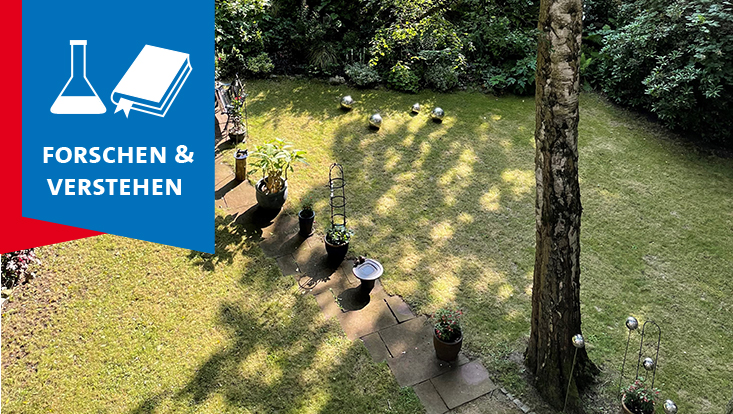Doing the Research: No. 31“A view of nature where you live is a very important factor”
12 June 2024, by Tim Schreiber

Photo: Universität Hamburg
A green environment is not a class privilege—at least in Hamburg. That is one of the findings in the Wohnen im Grünen project headed by Prof. Dr. Stefanie Kley. The professor of sociology at Universität Hamburg talks in the interview below about further findings and explains why green courtyards are so important for people.
Most people probably like to live somewhere surrounded by nature. You have focused on this issue in your project, Wohnen im Grünen, and conducted roughly 1,800 interviews. What did you discover?
Among other things, we specifically asked what people see when they look out their windows. We looked at 2 cities: Cologne and Hamburg. We discovered that in Hamburg, there are hardly differences between social classes when it comes to having a view of nature. In Cologne, however, it’s different. There are notable gradations.
Is Hamburg maybe just greener generally?
Yes, but natural areas are also more evenly distributed. Even residential areas with fewer wealthy people have a lot of green. And that is very different in other cities—certainly not just in Cologne. There is already research on the distribution of green spaces in cities, but it has not yet been done with a view to social class.
That’s good news for Hamburg!

Yes, that’s good news. Now we just have to keep it that way! Our green, tree-lined streets are especially helpful. But we also have a lot of neighborhoods here with green courtyards. Those are green oases. A green courtyard can provide a good balance to the surroundings, for example, traffic noise, which stresses people out.
What about other green areas, such as parks?
The proximity to public green spaces is also important to people, especially in certain circumstances, for example, in old age. For families, having your own garden is especially important. But practically speaking, green courtyards are important for all social groups when they decide whether to stay in the city or move.
So you don’t have to head to the country to enjoy nature?
Exactly. That is another finding in our study. To date, relatively little has been known about how important this greenery is when people decide to move away. Our research shows that for families with small children, it is very important to have your own garden. But in other phases of life, shared green spaces are also a good compensation and nature is a factor in the decision to stay.
And there is also an opposing trend: families that consciously choose life in the city. I can imagine that for these families, denser neighborhoods which still have peaceful, green oases are very attractive. This is an important finding for urban development, because there are efforts to encourage people to consider apartment buildings and to discourage them from the notion that, in a certain period of life, you must have your own house surrounded by green.
Is green important to all people or just for nature fans?
It’s important for all people, even those we might not describe as nature-lovers. Human beings respond to many things subconsciously. Nature has a measurable impact on the living satisfaction of all people and, beyond that, on their thoughts of moving away and concrete plans to do so. Generally, these are longer processes in which many things play a role: your job, schools for your children, etc. A view of nature and usable green spaces, however, are also an important factor in this whole list, and when it comes to the topic of where you live generally.
About the Project
Many studies show that trees, green spaces, and coastal zones are important for well-being but nobody can say how much green is vital to a livable city. Moreover, little is known about how valuable a green living environment is when it comes to thoughts of moving. For 4 years, the Wohnen im Grünen project looked at the importance of green spaces for urban dwellers and their quality of life as well as any decisions to move. The project ended in May 2024.
The project was based on a survey conducted twice, with 12 months between each round, in Hamburg and Cologne. People over 18 were randomly called in Hamburg and Cologne and asked questions for roughly half-an-hour. This resulted in an almost representative selection of 900 people per survey for the populations of Hamburg and Cologne.
Doing the Research
There are approximately 6200 academics conducting research at 8 faculties at Universität Hamburg. Many students also often apply their newly acquired knowledge to research practice while still completing their studies. The Doing the Research series outlines the broad and diverse range of the research landscape, and provides a more detailed introduction of individual projects. Feel free to send any questions and suggestions to the Newsroom editorial office(newsroom"AT"uni-hamburg.de).


